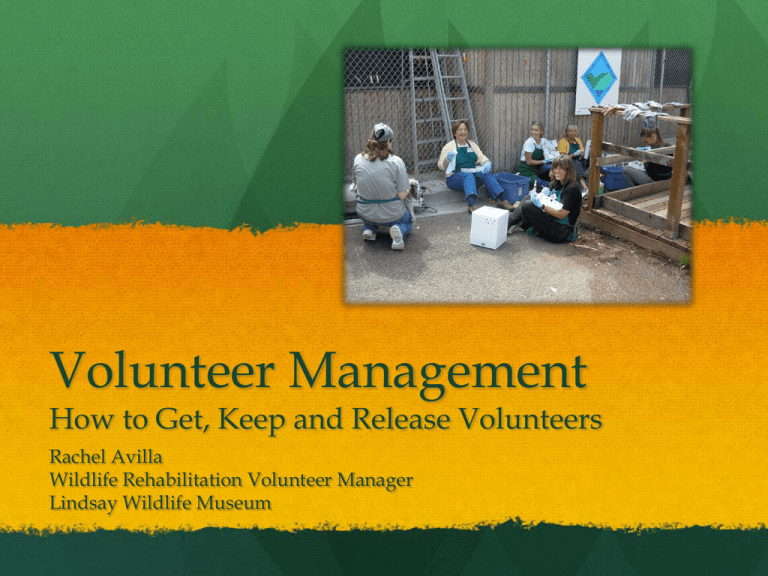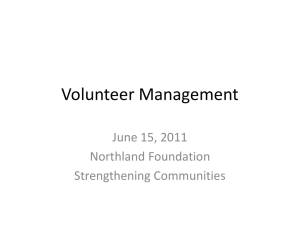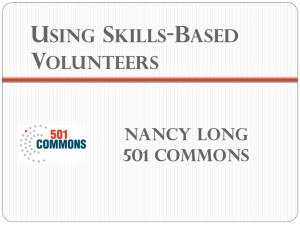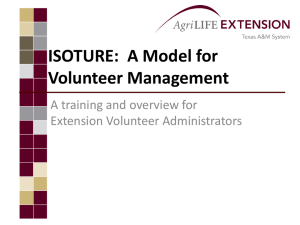Volunteer Management
advertisement

Volunteer Management How to Get, Keep and Release Volunteers Rachel Avilla Wildlife Rehabilitation Volunteer Manager Lindsay Wildlife Museum About Me Graduated from Saint Mary’s College with a B.S. in Environmental Sciences Wildlife Rehabilitation 11 years Started as an Intern at Santa Rosa Bird Rescue Intern and volunteer at Lindsay Wildlife Museum Staff at Lindsay Wildlife Museum for 8 years More About Me Six years volunteer manager at Lindsay Wildlife Museum Specialize in Volunteer Management, Swifts and Passerine Care particularly House Finches and Corvids About Lindsay Wildlife Museum Officially established rehabilitation hospital in 1970’s In 1980’s 10,000 animals a year 1990’s new building introduced species policy 8,000 animals a year developed the current training system Currently Museum Wide 500+ volunteers 80,000 hours of volunteer service each year 20,000 students a year 75,000 visitors a year Rehabilitation Hospital 350 rehabilitation volunteers Average of 5400 native animals a year 10’s of thousands of phone calls a year Why Volunteer Management? Without volunteers wildlife rehabilitation would not exist (no $$$$$) Quality care requires well trained, managed and dedicated volunteers Volunteers are a facilities greatest resource Most Important Points to Remember Be honest Training Structure Easy, simple and clear information Acknowledgement and appreciation Volunteers can do volunteer management Volunteering is a privilege, not a favor Recruitment Who People that bring in animals Local medical facilities, Nurses!!! Local retirement communities Other local animal rescue organizations Community Service (schools and courts) Recruitment How Fliers Local volunteer centers Website! Word of mouth Easily accessible information Effort Training Must have a pre-training program Better the training better the volunteers Longer the training → more committed the volunteers More organized the training → more comfortable the volunteers More prepared the volunteer → happier the volunteer Happy Volunteer = Better Animal Care Pre-Training Mandatory Introduction Class This is what you are getting yourself into Laundry, dishes, poop and food prep… Any ?’s Beginning Volunteer Training Charge small fee for class This is what you need to know before volunteering Pre-training Priorities Health and Safety Rules and Regulations Basic Anatomy and Physiology Handling Basic bird and or mammal care What ever your facility specializes in Pre-Training Tips No more that 2 hours Lectures and Labs combined in 2 hours Lots of cool pictures in presentations Handouts to compliment training Homework Videos of class Bring in animals halfway through training No preferential treatment Lindsay Wildlife Museum’s Method Introduction to Wildlife Class 3 times a year in Oct. and Jan., charge $65 for class Core Curriculum Training Program 1 time a year Feb.-Mar. There are 7, two hour classes totaling 14 hours of pre-training. Provide 3 different sections to maximize flexibility in schedules for new volunteers Been doing it this way for 25 years, it works! Continuing Education Natural History and Care of Species Advanced handling and restraint classes Medications Nutrition Husbandry and enrichment Have a system of what new volunteers can do and what they can achieve with time Without potential for advancement… What’s the point? Releases Rescue training Be creative and use your strengths Laundry On-shift Trainings Make sure all volunteers are on the same page for all house keeping needs Dishes Cage Cleaning Enclosure set-ups Medications Diet preparation Pool cleaning Almost all skills Volunteer Maintenance Avoid Burnouts Shift Unity Shift Structure Special Opportunities Recognition of Years Volunteering Keep Updated and Involved Appreciation Events Lindsay Wildlife Museum’s Method Short frequent shifts Shift leaders and mentors on every shift Before and end of season meetings Involve them when something cool is happening Check up on them and get to know them Release of Volunteers They Leave Because Life happens Bored Not a good fit Confusion and frustration Lack of supervision Staff or other volunteers We Release Because Blatant disregard of policies or protocols Inappropriate injury to themselves, an animal or another volunteer Inappropriate interaction with another volunteer or staff. Before Our Volunteers Start Committed to 9 meetings A grand total of 18 hours of training Completed all necessary paperwork They are worthy of becoming a volunteer Volunteering is a privilege, not a favor Other Requirements There should be requirements for maintaining an active volunteer status Yearly membership Minimum hour completion Continuing education Thank You











